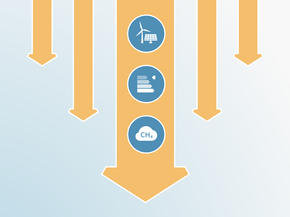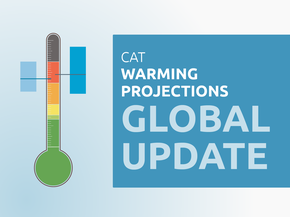Assumptions
Historical emissions
Historical emissions are taken from the PRIMAP data for the period 1990-2023 (Gütschow et al., 2025).
LULUCF emissions are taken directly from India’s fourth Biennial Report released in December 2024 (Government of India, 2024). These estimates are calculated using global warming potential (GWP) values from the IPCC’s second assessment report. We have not converted these into AR5 values because the contribution from non-CO2 gases is negligible.
NDC and other targets
2030 target
Emissions intensity target - Unconditional Target
Historical GDP data for 1990-2023 is taken from Reserve Bank of India, while GDP data for 2024 is from IMF (IMF, 2025; Reserve Bank of India, 2024). We estimate the 2030 GDP using IMF GDP growth estimates for 2025-2030 and trend estimates for the rest of the decade (IMF, 2025)
We calculate the emissions intensity in 2005 by dividing the historical 2005 GHG emissions with the 2005 GDP value. We then apply the government’s 45% reduction target to the 2005 emission intensity to estimate the 2030 emission intensity. Lastly, we multiply the 2030 GDP from the Reserve Bank of India with our calculated 2030 emission intensity to estimate emissions in 2030, which we quantify as 4.99 MtCO2 as the unconditional target.
As India has a separate target to enhance its carbon sink, we assume that LULUCF has been excluded from its emissions intensity target. It has not provided a historical estimate for LULUCF for 2005 in its GHG inventory.
50% non-fossil installed capacity target - Conditional Target
The 50% non-fossil capacity target is based on the current policy pathway (details below) and is calculated by replacing non-fossil power with fossil power. This is necessary because, as discussed above, the NEP2023 includes more than 50% non-fossil capacity for 2030. We use the generation factor of the underlying scenario (WEO2024 or slow progress NEP2023) to calculate the extent of non-fossil generation and then subtract that from total generation to derive the new level of fossil generation. We use the emissions factor of the underlying scenario to determine the level of emissions and then harmonise the anticipated higher emissions to our current policy scenario.
Net-zero target and other long-term targets
We estimate India’s emissions in 2070 consistent with its net zero target for the purpose of our global temperature estimate.
We assume that India achieves the top end of its carbon sink NDC target of 3 GtCO2, which we average over the 2016-2030 period for an annual additional sink of 200 MtCO2. We add this to the last historical emissions data for LULUCF (308 MtCO2 in 2016), for an estimated sink of 508 MtCO2 in 2070, and assume that this will reflect India’s residual level of emissions of its net-zero target.
Current policy projections
CO2 emissions
We quantify a range of CO2 emissions projections under current policies.
Lower end of the scenario range: We use the growth rates from the IEA’s World Energy Outlook 2024 (WEO 2024) Stated Policies Scenario for India’s CO2 emissions and harmonised with the historical emissions of CO2. This scenario includes the non-fossil capacity addition target of 68% from national Electricity Plan 2023. The IEA’s CO2 emissions estimate now includes industry process emissions and thus is a good proxy for all of India’s CO2 emissions (IMF, 2025).
Upper end of the scenario range: We use emission from the Niti Aayog for the years 2021-2024 to compare the progress in implementation of NEP2023 (Ministry of Power, 2023b). That indicates that 2022 power sector emissions have already exceeded NEP2023 projections for 2026, despite lower-than-planned fossil capacity expansion. This is largely due to higher utilisation rates of fossil plants and slower-than-expected growth in renewable generation. As NEP2023’s 2026 emissions target was already exceeded in 2022, a slow progress NEP scenario is constructed as follows:
- We have assumed a three-year delay in the milestones of non-fossil generation targets (e.g., 2026 target will be achieved in 2029).
- Assuming the projection of total generation as provided in the NEP2023, will remain constant, fossil fuel generation is derived by subtracting non-fossil generation from the total.
- Using the constant generation factor between fossil and non-fossil sources as provided in NEP2023, the updated emissions for power sector are calculated accordingly.
We begin by extracting the CO2 emissions projections for all energy from the WEO2024 dataset and then remove the portion attributed to the power sector. This gives us the non-power sector emissions. Next, we replace the WEO power sector CO2 projections with those from the NEP slow progress scenario. The adjusted power sector emissions are then added back to the non-power sector emissions, resulting in a new all energy CO2 emissions projection. From this combined trajectory, we derive the annual growth rate, which is then applied to the historical 2023 total CO2 emissions data point to extrapolate emissions until 2030.
Other gases
We use the US EPA non-CO2 emissions projection growth rates for the CH4, N20 and F-gases and harmonise these to the latest historical year (U.S. Environmental Protection Agency, 2019).
Note: Our data download includes projections until 2035; however, our graphics display the data until 2030 only.
Global warming potentials
The CAT uses Global Warming Potential (GWP) values from the IPCC's Fifth Assessment Report (AR5) for all its figures and time series, unless otherwise stated. Assessments completed prior to December 2024 (COP29) used GWP values from the Fourth Assessment Reports (AR4) and those completed prior to December 2018 (COP24) used GWP values from the Second Assessment Report (SAR).
Further analysis
Latest publications
Stay informed
Subscribe to our newsletter




